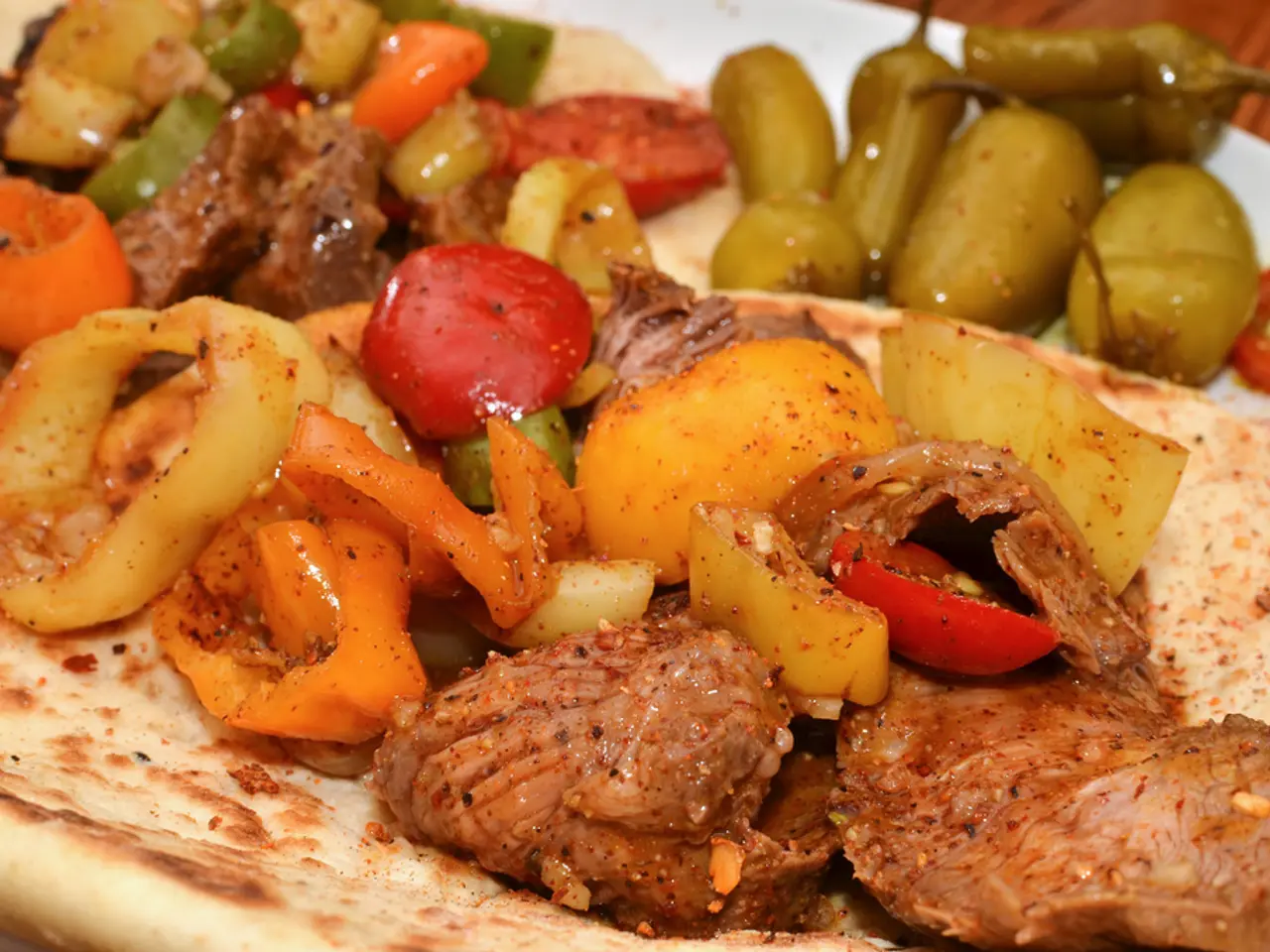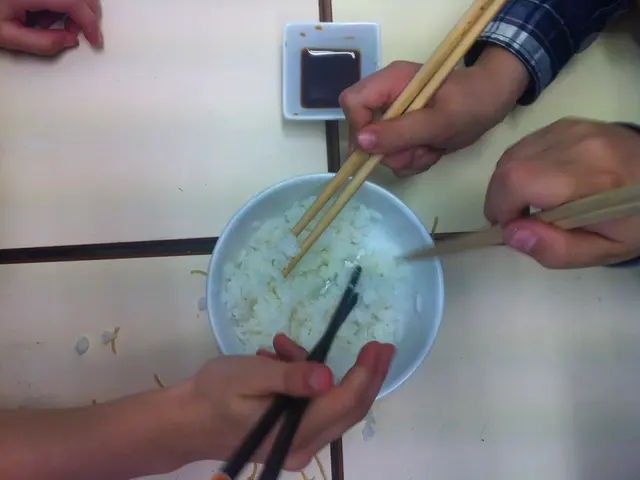Experience the Rich Flavors of Traditional Hispanic Food: 20 Identifiable, Authentic Dining Options and Their Roots
From the Caribbean to Central America, South America, and Spain, Hispanic cuisine offers a rich tapestry of flavours and traditions. This article takes you on a journey through some of the most iconic dishes that define this diverse culinary landscape.
Arepas, golden cornmeal pockets, are a daily staple in Venezuela and Colombia. Originating as a traditional cornmeal dish deeply rooted in the indigenous cultures of these countries, arepas are considered a symbolic "bread" in both nations. In Venezuela, they are enjoyed throughout the day and typically grilled or fried, often split and filled with various ingredients such as cheese, meats, or eggs. In Colombia, particularly along the Caribbean coast, arepas are often deep-fried, sometimes with egg inside, and are a popular street food usually accompanied by spicy sauces like ají; they are commonly eaten for breakfast or as an afternoon snack [1].
Tostones, twice-fried plantain medallions, are popular as a side dish or snack throughout the Caribbean and Latin America. These crispy, salty treats are a perfect companion to many meals, offering a delightful contrast in texture and flavour [2].
Pupusas Con Curtido, El Salvador's national dish, consist of thick corn tortillas filled with cheese, beans, or meat, and are served with tangy pickled vegetables. These hearty treats are a testament to the country's culinary ingenuity and are a beloved part of El Salvador's cultural heritage [3].
Mole Sauce, a complex, chocolate-kissed sauce originating from Mexico, is often served during special occasions. This rich, flavourful sauce is a testament to Mexico's culinary prowess and is a staple at Mexican celebrations [4].
Burritos, Mexico's most internationally beloved culinary export, consist of a flour tortilla embracing a variety of fillings. From simple beans and cheese to more elaborate combinations of meats, vegetables, and sauces, burritos offer a versatile and delicious meal option [5].
Quesadilla, a grilled cheese-filled tortilla, is popular as comfort food in Mexico. This simple yet satisfying dish is a perfect example of the country's love for cheese and tortillas [6].
Gallo Pinto, a traditional Central American rice and beans dish typically served at breakfast throughout Costa Rica and Nicaragua, is another testament to the region's culinary heritage. This dish, with its distinctive flavour and texture, is a delicious way to start the day [7].
Hispanic cuisine encompasses the rich culinary traditions of Spanish-speaking countries primarily in South America, Central America, the Caribbean, and Spain. From the vibrant flavours of Mexico to the comforting desserts of Spain, this diverse culinary landscape offers a wealth of delicious and unique dishes to explore [8].
In summary, Hispanic cuisine is a rich tapestry of diverse cultures, spanning from Spain to Mexico and the Caribbean. From arepas to burritos, mole sauce to pupusas, each dish offers a glimpse into the unique culinary heritage of the countries it represents. Whether enjoyed at home or on the street, these dishes are a testament to the enduring power of food to connect us, to celebrate our shared history, and to bring joy to our lives.
References: [1] Arepa - Wikipedia, the free encyclopedia. (n.d.). Retrieved January 20, 2023, from https://en.wikipedia.org/wiki/Arepa [2] Tostones - Wikipedia, the free encyclopedia. (n.d.). Retrieved January 20, 2023, from https://en.wikipedia.org/wiki/Tostones [3] Pupusa - Wikipedia, the free encyclopedia. (n.d.). Retrieved January 20, 2023, from https://en.wikipedia.org/wiki/Pupusa [4] Mole (sauce) - Wikipedia, the free encyclopedia. (n.d.). Retrieved January 20, 2023, from https://en.wikipedia.org/wiki/Mole_(sauce) [5] Burrito - Wikipedia, the free encyclopedia. (n.d.). Retrieved January 20, 2023, from https://en.wikipedia.org/wiki/Burrito [6] Quesadilla - Wikipedia, the free encyclopedia. (n.d.). Retrieved January 20, 2023, from https://en.wikipedia.org/wiki/Quesadilla [7] Gallo Pinto - Wikipedia, the free encyclopedia. (n.d.). Retrieved January 20, 2023, from https://en.wikipedia.org/wiki/Gallo_Pinto [8] Hispanic cuisine - Wikipedia, the free encyclopedia. (n.d.). Retrieved January 20, 2023, from https://en.wikipedia.org/wiki/Hispanic_cuisine
- Exploring the food-and-drink scene in a Hispanic region offers not only a taste of healthy, delicious recipes but also a glimpse into the rich cultural travel and lifestyle of the area.
- From learning about the intricate process of making Mole Sauce in Mexico to mastering the art of creating Quesadillas, cooking lessons can provide an immersive experience into the cultural travel of Spanish-speaking countries.
- A nutritious morning might include enjoying Gallo Pinto in Costa Rica or Nicaragua, and a afternoon snack could be tasting Colombia's deep-fried Arepas with spicy ají sauce.
- Traveling through Hispanic cuisine’s diverse landscapes allows you to savor iconic dishes such as El Salvador's Pupusas Con Curtido, Arepas from Venezuela and Colombia, or Tostones from the Caribbean, each representing the unique flavors of their region.
- In addition to being a delight to the taste buds, incorporating these traditional dishes into our lifestyle promotes a deeper understanding and appreciation of the shared history and diverse traditions within Spanish-speaking cultures.
- As we continue to broaden our food-and-drink horizons, exploring the diverse delicacies of Hispanic cuisine not only enhances our palate but also provides a more holistic understanding of the world, enriching our cultural travel and lifestyle experiences along the way.




